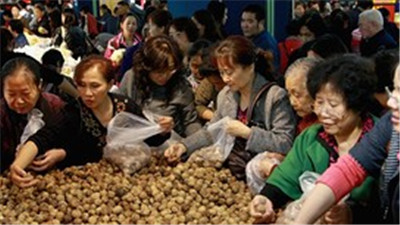Foreign big-box retailers have found the going extremely tough in China. Having flooded in over the past two decades seeking to tap into rising demand from China’s emerging middle class, many big names, from Best Buy to Tesco, have subsequently been forced to admit defeat, faced with fierce local competition and a rapidly changing retail landscape.
国际大型零售商发现,自己在中国的经营陷入了极其艰难的境地。它们在过去20年间涌入中国、试图充分挖掘中国新兴中产阶级日益扩大的需求,但面对来自中国本土零售商的激烈竞争以及快速变化的零售业格局,从百思买(Best Buy)到乐购(Tesco)等诸多零售业巨头后来不得不承认失败。

US retail giant Walmart appears to be bucking this trend. Despite slowing sales — Walmart’s same-store sales have declined on an annual basis in each of the past four quarters for which it has announced results, most recently a 2.3 per cent year-on-year decline in the three months to January — the world’s largest retailer by sales remains committed to expanding its China footprint. Moreover, while both local and multinational rivals are diversifying their store formats, Walmart remains committed to big-box hypermarkets.
美国零售巨头沃尔玛(Walmart)却似乎在逆势而进。虽然销售放缓——根据其公布的财报,沃尔玛同店销售额在过去四个季度中的每一个季度都出现同比下降,在截至今年1月的最近的这个季度里同比下降了2.3%——但这家销售额排名全球第一的零售商仍致力于在华扩张。此外,虽然中国本土和跨国竞争对手都在使自己的门店形式变得更加多样,但沃尔玛仍固守大卖场模式。
On the surface, data from China Confidential, a research service from the Financial Times, suggest this continued commitment to China may pay off. Walmart has remained the most-visited supermarket brand among shoppers surveyed by China Confidential over the past three years, even as multinational rivals such as Carrefour and Tesco have seen their popularity dwindle.
英国《金融时报》旗下调研机构《中国投资参考》(China Confidential)的数据显示,表面上看,这种对中国的持续投入可能会收到成效。《中国投资参考》过去三年对购物者的调查发现,沃尔玛仍是购物者光顾最多的超市品牌,尽管家乐福(Carrefour)、乐购等跨国同行在华人气呈现下降。
More than 30 per cent of supermarket shoppers continue to shop regularly at Walmart’s 412 stores in 165 cities nationwide, ahead of Carrefour and local rivals such as Sun Art’s RT-Mart chain. Meanwhile, specialist online grocery retailer Yihaodian, in which Walmartowns a majority stake, has also enjoyed success, especially among consumers in China’s largest cities. Twelve per cent of shoppers in first-tier cities said they regularly made grocery purchases on Yihaodian.
逾30%的超市购物者仍定期到沃尔玛在全中国165个城市的412家门店购物,这一比例领先于家乐福以及中国本土竞争对手,比如高鑫零售(Sun Art)旗下的大润发(RT-Mart)连锁超市。与此同时,沃尔玛持有多数股权、专营日用品的在线零售商“1号店”也取得了成功,尤其受到中国大城市消费者的欢迎。中国一线城市12%的购物者表示,他们定期在1号店购买日用品。
However, this headline success masks significant shifts in consumer preference which may undermine Walmart’s popularity in the future. Rival retailers continue to gain ground, tapping into the rising premium placed on convenience by increasingly time-poor consumers, as well as growing health consciousness. Domestic and Japanese convenience store brands already have a large presence in major cities and are expanding rapidly into lower-tier cities. Some 78 per cent of consumers surveyed by China Confidential at the end of last year said they regularly shopped at convenience stores, rising to 88 per cent among shoppers in first-tier cities. Although previous forays into this sector from big-box retailers such as Tesco have ended in failure, Walmart’s lack of presence in this market is a potential concern given slowing industry-wide hypermarket and supermarket revenue growth, a trend likely to continue in 2015.
但在这种看得见的成功的背后,是消费者偏好的重大改变,这种改变可能会削弱沃尔玛未来的受欢迎程度。由于消费者空闲时间越来越少,因此他们越来越注重购物的便利性,另外他们的健康意识也在日益增强,沃尔玛的竞争对手充分利用这两点、不断攻城略地。中国本土以及日本的便利店品牌已在中国大城市占据很大的地盘,同时也在中小城市迅速扩张。《中国投资参考》去年底调查的消费者中,约78%的受访者称,他们定期到便利店购物,而在一线城市中这一比例高达88%。尽管乐购等大型零售商此前进军这一领域以失败告终,但沃尔玛在这块市场没有布局是一大隐患,尤其是考虑到大卖场和超市收入增长放缓这一全行业性的趋势很可能会在2015年延续。
Furthermore, Walmart’s positioning appears less clear than some of its faster-growing rivals. Domestic brand Yonghui Superstores, for example, has enjoyed double-digit revenue and profit growth in recent years by focusing on fresh, local produce, with at least 60 per cent of its meat and vegetables directly sourced from local farms. Having initially focused on regional markets such as Fujian and Chongqing, it is now looking to expand into larger markets, with plans to have 100 stores in Shanghai by 2017, where 80 per cent of floorspace will be dedicated to fresh vegetables, meat and fish. This strategy is already bearing fruit: 8.2 per cent of consumers said they regularly shopped at Yonghui at the end of 2014, up from 5.7 per cent at the end of 2013.
此外,沃尔玛的定位比起一些增长更快的竞争对手似乎也不够清晰。例如,中国本土品牌永辉超市(Yonghui Superstores)专营本地产新鲜农产品(其出售的肉类和蔬菜至少有60%直接采购自所在地农场),近年来取得了两位数的收入和利润增长。最初只聚焦于福建、重庆等地方市场的永辉超市,现在正考虑进军更大的市场,计划到2017年时在上海开设100家门店,其中80%的店面将专门用于供应新鲜蔬菜、肉类和鱼。这一战略已开始收到效果:2014年底,8.2%的消费者称,他们定期到永辉购物,较2013年底的5.7%有所上升。
All of which is not to say that Walmart’s expansion-driven strategy in China is doomed to failure. Despite being embroiled in several high-profile bad news stories in recent years, it retains a strong brand, while its large presence gives it strong bargaining power and economies of scale, although it has less of an advantage in lower-tier markets where local rivals already have well-established relationships. But its big-box approach appears increasingly old-fashioned in a rapidly changing and diversifying market.
这一切并不意味着,沃尔玛由扩张驱动的在华战略注定会失败。虽然近年来卷入了几起备受关注的丑闻,但沃尔玛品牌仍具有强大的吸引力,门店数量众多给它带来了强大的议价能力和规模效益,尽管它在中国本土竞争对手已建立完善关系的中小市场并不占什么优势。不过,在快速变化和日益多元化的市场中,沃尔玛的大卖场模式似乎显得越来越跟不上时代。













